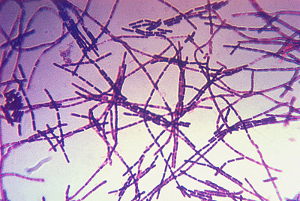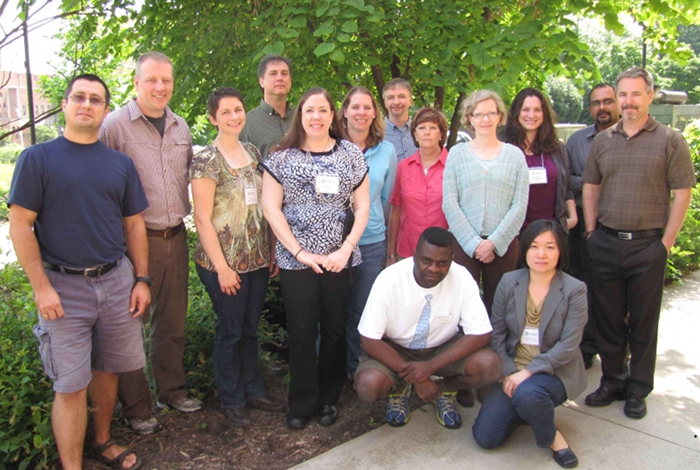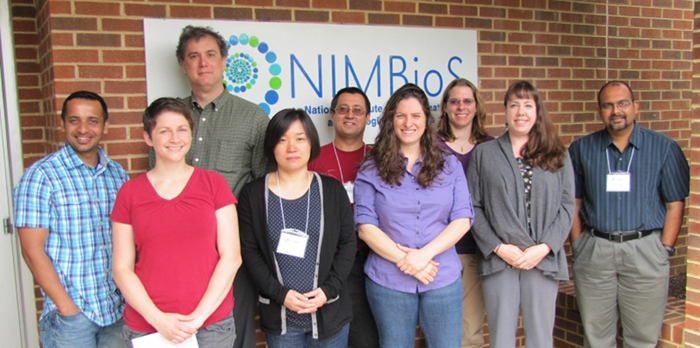| Description | Participants | Summaries | Products |
|---|
Archived NIMBioS Working Group
Modeling Low Dose Exposure to Inhalation Anthrax

Topic: Modeling Low Dose Exposure to Inhalation Anthrax
Organizers:
Judy Day
(Dept. of Mathematics, Univ. of Tennessee, Knoxville)
Sarah Taft
(US Environmental Protection Agency, Office of Research and Development, Cincinnati, Ohio)
Meeting dates: May 15-17, 2012; Nov 13-15, 2012; May 15-17, 2013
Objectives. Site-specific risk-based decision making following a biological threat agent release poses extremely difficult and unique challenges, especially for a persistent agent such as Bacillus anthracis. Inhalation exposure risk from B. anthracis spores can result from aerosolized spores during a terrorist attack, subsequent reaerosolized spores before cleanup takes place, or reaerosolized residual spores after remediation is complete. Decision makers and responders will be faced with very difficult questions such as "What dose causes disease?", "How clean is clean?", or "What are the health effects of chronic exposures to residual spores?". This group will focus on developing mathematical models that are closely integrated with experimental data to answer some of these questions and better understand the human health effects specifically to low dose exposures of residual or reaerosolized B. anthracis spores after a potential event.

Meeting Summaries
| Mtg # | Dates | Agenda | Summary | Photo | Evaluation |
|---|---|---|---|---|---|
| 1 | May 15-17, 2012 | Link | Link | Report | |
| 2 | Nov 13-15, 2012 | Link | |||
| 3 | May 15-17, 2013 | Link | Link |
Meeting 1 Summary. The first meeting began with individuals giving "verbose introductions" to help facilitate getting to know one another. Afterward, most of the first day was dedicated to introductory talks on anthrax biology, experimental data, and mathematical modeling approaches with much discussion throughout. This was followed by a group brainstorming session for the purpose of identifying areas of research (experimentally and modeling) at various stages of development with respect to anthrax exposure. This information was organized in the context of a "box" approach by identifying various stages of anthrax disease from deposition of spores to outcome and application to risk assessment. The final day continued as a whole group discussion on identifying "next steps" related to the gathered information. Members were associated (by their preference) with these items, so that those individuals could communicate with the appropriate people between now and the next meeting, which is scheduled for fall 2012.
Meeting 2 Summary. The second meeting of the Low Dose Anthrax Exposure Working Group began with presentations from various group members that updated the WG on work done between the first meeting and this meeting. Throughout each presentation, other members provided comments/suggestions and asked questions, providing each presenter thorough feedback on the work they had done. Three subgroups were defined prior to this meeting and next steps for the work within groups were mapped out during the 2nd meeting. Subgroup 1 focuses on modifying/expanding existing ODE models and Building New Boxed-Based Models; Subgroup 2 focuses on data inventory and management; and Subgroup 3 focuses on “Top-down” modeling approaches for both single and multi-dose exposures.
Meeting 3 Summary. The third meeting of the Low Dose Anthrax Exposure Working Group (WG) began with informal presentations from various group members that updated the WG on work done between the second and third meetings. Before the meeting, members were asked to think about what kinds of outputs might come from the WG efforts on which they had been focusing; after each update, members then discussed their vision for possible tangible outputs from their WG efforts. Examples of outputs might include a manuscript to be submitted to peer reviewed journal, an abstract for a presentation/poster discussing (preliminary) work, or a data repository. WG members also discussed data and information gaps that would be helpful to push these goals and outputs forward (e.g. specific data, assistance from other members). Needed data gaps were prioritized according to 1) if it had the most impact on achieving the originally stated goals of the working group and 2) if it had the most work completed to date. Members then chose which of the data gaps they primarily wished to work on during the meeting and then spent most of the meeting focusing on pushing these initiatives forward.
 |
| Mtg. 1 participants. (From left): Vitaly Ganusov, Brad Gutting, Judy Day, Philip Hanna, Sarah Taft, Megan Powell, Conrad Quinn, Judith Hewitt, Louise Pitt, Angela Reynolds, Harish Shankaran, Justin Teeguarden; (Kneeling): Calistus Ngonghala and Hyang Mi Kim. Not pictured: Charles Haas and Richard McNally |
 |
| Mtg. 3 participants. (L to R): Buddhi Pantha, Judy Day, Phillip Hanna, Hyang Mi Kim, Vitaly Ganusov, Angela Reynolds, Megan Powell, Sarah Taft, Harish Shankaran |
NIMBioS Working Groups are chosen to focus on major scientific questions at the interface between biology and mathematics. NIMBioS is particularly interested in questions that integrate diverse fields, require synthesis at multiple scales, and/or make use of or require development of new mathematical/computational approaches. NIMBioS Working Groups are relatively small (up to 10 participants), focus on a well-defined topic, and have well-defined goals and metrics of success. Working Groups will meet up to 3 times over a two-year period, with each meeting lasting up to 2.5 days.
A goal of NIMBioS is to enhance the cadre of researchers capable of interdisciplinary efforts across mathematics and biology. As part of this goal, NIMBioS is committed to promoting diversity in all its activities. Diversity is considered in all its aspects, social and scientific, including gender, ethnicity, scientific field, career stage, geography and type of home institution. Questions regarding diversity issues should be directed to diversity@nimbios.org. You can read more about our Diversity Plan on our NIMBioS Policies web page. The NIMBioS building is fully handicapped accessible.
NIMBioS
1122 Volunteer Blvd., Suite 106
University of Tennessee
Knoxville,
TN 37996-3410
PH: (865) 974-9334
FAX: (865) 974-9461
Contact NIMBioS


